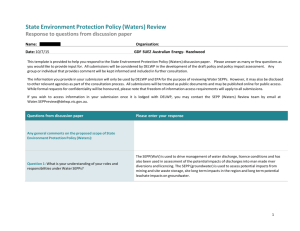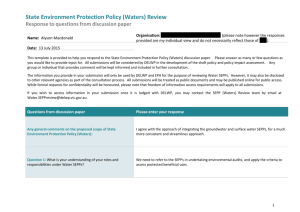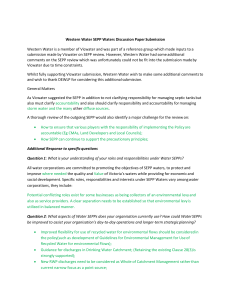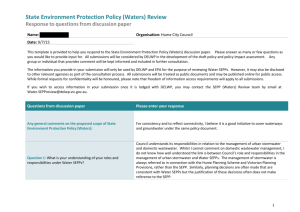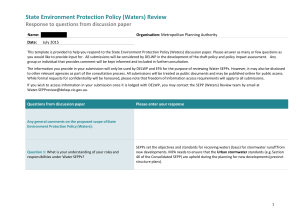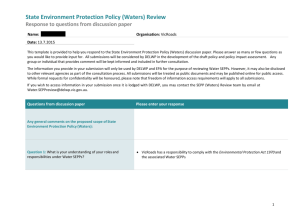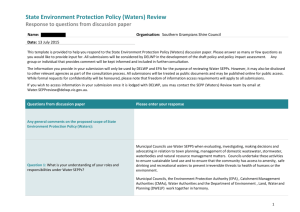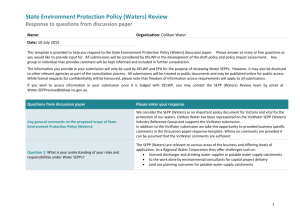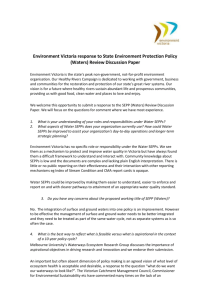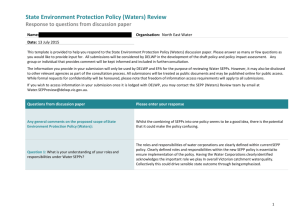Goulburn-Broken CMA - Department of Environment, Land, Water
advertisement
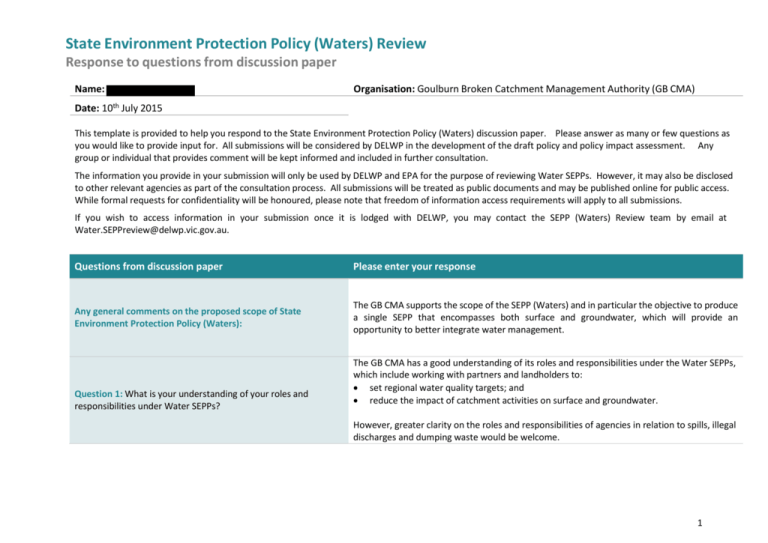
State Environment Protection Policy (Waters) Review Response to questions from discussion paper Name: Organisation: Goulburn Broken Catchment Management Authority (GB CMA) Date: 10th July 2015 This template is provided to help you respond to the State Environment Protection Policy (Waters) discussion paper. Please answer as many or few questions as you would like to provide input for. All submissions will be considered by DELWP in the development of the draft policy and policy impact assessment. Any group or individual that provides comment will be kept informed and included in further consultation. The information you provide in your submission will only be used by DELWP and EPA for the purpose of reviewing Water SEPPs. However, it may also be disclosed to other relevant agencies as part of the consultation process. All submissions will be treated as public documents and may be published online for public access. While formal requests for confidentiality will be honoured, please note that freedom of information access requirements will apply to all submissions. If you wish to access information in your submission once it is lodged with DELWP, you may contact the SEPP (Waters) Review team by email at Water.SEPPreview@delwp.vic.gov.au. Questions from discussion paper Please enter your response Any general comments on the proposed scope of State Environment Protection Policy (Waters): The GB CMA supports the scope of the SEPP (Waters) and in particular the objective to produce a single SEPP that encompasses both surface and groundwater, which will provide an opportunity to better integrate water management. Question 1: What is your understanding of your roles and responsibilities under Water SEPPs? The GB CMA has a good understanding of its roles and responsibilities under the Water SEPPs, which include working with partners and landholders to: set regional water quality targets; and reduce the impact of catchment activities on surface and groundwater. However, greater clarity on the roles and responsibilities of agencies in relation to spills, illegal discharges and dumping waste would be welcome. 1 State Environment Protection Policy (Waters) Review Response to questions from discussion paper Question 2: What aspects of Water SEPPs does your organisation currently use? How could Water SEPPs be improved to assist your organisation’s day-to-day operations and longer-term strategic planning? The GB CMA principally use the water quality standards in the Water SEPPs to: inform regional water quality targets; inform the development and implementation water quality monitoring programs; identify water quality risks; and inform the development and assessment of regional water quality strategies. Other aspects of the Water SEPPs are used to inform our long term planning. Question 3: Do you have any concerns about the proposed working title of State Environment Protection Policy (Waters)? If so, what are they? Question 4: What is the best way to reflect what is feasible versus what is aspirational in the context of a 10-year policy cycle? The GB CMA does not object to the proposed working title. As stated, clearly articulating what improvements in water quality protection are practical or feasible versus what is aspirational. The challenge will be to identify practical or feasible improvements, which will be variable across and within systems and influenced by a variety of economic and social factors. It should also be recognised that appropriate resources need to be provided to support the implementation of the SEPP (Waters). Question 5: Do you support the proposed SEPP (Waters) objective of “this policy is to protect and improve the quality of Victoria’s waters while providing for economic and social development”? Why? The GB CMA supports the proposed SEPP (Waters) objective. Question 6: Do you support the need to balance economic and social development with overall protection and improvement of water quality for Victoria’s water environments? Why? The GB CMA supports the need to balance economic and social development with overall protection and improvement of water quality for Victoria’s water environments. This will help ensure protection and improvement measures are practical, achievable and acceptable to the community. 2 State Environment Protection Policy (Waters) Review Response to questions from discussion paper The key challenge of balancing economic and social development with protecting and improving water quality is quantifying and assessing the trade-offs between them (cost benefit analysis). Question 7: What are the challenges of balancing economic and social development with protecting and improving water quality? How should we manage the appropriate trade-offs between them? The process used to manage the trade-offs between economic and social development with protecting and improving water quality needs to be transparent, defensible and consultative. The impact of trade-offs should also be monitored and evaluated. Minimum water quality standards could also be established for different waterway states (e.g. highly modified, sustainable working, ecologically healthy and near natural as identified in the Victorian Waterway Management Strategy) which cannot be traded-off. Question 8: Do you foresee any problems or opportunities that may arise from creating one consistent SEPP to apply to all Victorian waters? Are there other options for streamlining the policies that we should consider? The GB CMA believes having one consistent SEPP that applies to all Victorian Waterways will provide an opportunity for more consistent and integrated water management. Question 9: Are there any specific types of water environments, for example, a wastewater treatment lagoon, where you think beneficial uses should not be protected? Irrigation drains, farm dams and farm effluent ponds are specific types of water environments where beneficial uses should not be protected. Question 10: Do you think the current measures for classifying surface water and groundwater segments are still appropriate? Are there other measures that should be explored? The current measures for classifying surface water segments are still appropriate. However, where it is practical and beneficial they should be aligned to other relevant water management boundaries such as the surface water and groundwater resource plan areas identified in the Basin Plan. 3 State Environment Protection Policy (Waters) Review Response to questions from discussion paper Question 11: Are there any problems with the spatial arrangements or segment boundaries in the existing Water SEPPs? If so, what are they? Question 12: What do you think are the advantages or problems with the new approach to segments and sub-segments? The GB CMA has not identified any problems with the spatial arrangements or segment boundaries in the existing Water SEPPs. However, transitional boundaries between segments rather than hard boundaries could allow for informed interpretation. The new approach to segments and sub-segments may allow for more realistic water quality standards or targets to be set. This conversely may reduce the incentive to improve water quality in areas where water quality standards are low and currently met. The GB CMA would like to see sub-segment definitions for irrigation areas before commenting on their potential advantages or problems. Question 13: Are there any features of the landscape that you would like to see as a standalone segment or sub-segment? Not in our region. Question 14: Do you believe that all beneficial uses set out in Table 2 of the discussion paper should still be protected under the new SEPP (Waters)? Where do you think a beneficial use would not apply? Why? The list of beneficial uses is extensive and covers most conceivable uses of water. However, the beneficial uses could be consolidated across water types (e.g. the agriculture and irrigation beneficial use could be combined with the agriculture, parks and gardens beneficial use) and the beneficial uses of passage of indigenous fish and maintenance of indigenous riparian vegetation could apply to all rivers just not rivers in the Yarra Catchment. Question 15: What method or approach could be used to apply the beneficial uses to segments and sub-segments? Beneficial uses could be applied to waterways in segments based on their state (e.g. highly modified, sustainable working, ecologically healthy and near natural as identified in the Victorian Waterway Management Strategy), condition (e.g. ISC and IWC scores), conservation status, land status and AVIRA scores. Beneficial uses could also be developed in consultation with local communities and agencies to ensure associated protection and improvement measures are practical, achievable and acceptable. 4 State Environment Protection Policy (Waters) Review Response to questions from discussion paper Question 16: Are there any additional beneficial uses that you believe should be protected? Are there any that you think should no longer be protected? Why? Question 17: What do you think about the current indicators, the approach for deriving objectives and the proposed changes? There are no additional beneficial uses that we believe should be protected and there are no existing beneficial uses that we believe should no longer be protected. The GB CMA supports the current indicators, the approach for deriving objectives and the proposed changes. However, there could be scope for: a water temperature indicator to highlight issues; an indicator that considers macroinvertebrate biomass or abundance of prey species important for the maintenance of fish populations; time thresholds for indicators to account for natural variability (e.g. DO levels below 5 mg/L for extended periods of time may impact native fish, but short periods may not); and tiered objectives that take into account the states of waterways. The GB CMA has experience in using load targets in our water quality strategy which focussed on load reduction rather than concentration improvement (the assumption being that if loads improved concentrations should also improve). The load approach has worked well and makes reporting of water quality improvement activities uncomplicated. For example it is easy to say the discharges from Wastewater Management have declined from 50 t of TP to 2 t of TP. Question 18: How have nutrient load targets been useful in driving environmental investment outcomes? Would you like to see a different approach, and if so, what might that be? Load management approaches as applied in the US appear to be clumsy and difficult to apply. We need to recognise that large loads are often associated with high flow events which makes their management very difficult. Managing loads at low flows might also be difficult if there is no hydrological connection between the source and the receiving water as is often the case with diffuse sources during no rainfall periods. Nevertheless load management is a useful tool and consideration of pollutant yields in terms of kg/ha/year is very useful in aiding prioritisation. 5 State Environment Protection Policy (Waters) Review Response to questions from discussion paper Question 19: What is the preferred method for management of at-risk areas? Are there activities that need greater intervention or regulation? What would the intervention be, for example, voluntary or mandatory codes of practice, regulation via licensing? Question 20: What do you think the role of SEPP (Waters) should be in identifying and filling knowledge gaps over the life of the policy? How can we assure an adaptive approach within SEPP (Waters)? Any other information you would like to share: At present CMAs work in voluntary partnerships with landholders to undertake management activities. Therefore, the achievement of desired water quality objectives in priority areas is largely dependent upon landholder support. Actions outlined in the Victoria Waterway Management Strategy to improve the administration and management of Crown frontages may assist their protection and the achievement of desired water quality objectives. SEPP (Waters) should identify and prioritise key knowledge gaps and outline how they will be filled over the life of the plan. Adaptive management approaches should be built into SEPP (Waters). This could include a MERI framework or an adaptation pathways approach. Whatever the approach taken, there needs to be targeted monitoring, reporting and evaluation at an appropriate frequency. Regions need to be strongly involved in this process. In addition, funded monitoring to demonstrate SEPP compliance is required. Where practical the development and implementation of Implementation Plans should utilise existing regional bodies and arrangements to minimise duplication and costs. 6
